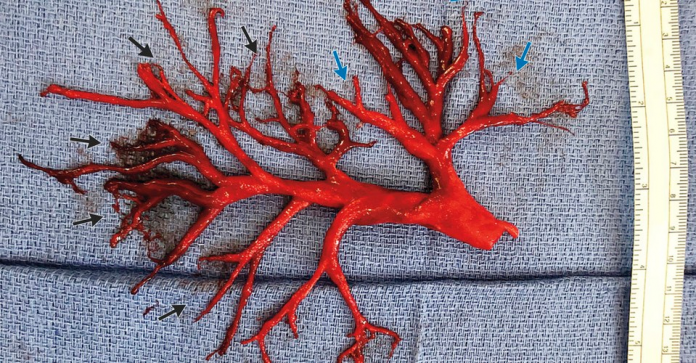The New England Journal of Medicine added the most visually astonishing case study to its photo series. The image, resembling a cherry-red chunk of a bright coral reef or underground root was of a six-inch wide human blood clot. The blood clot resembled the right bronchial tree and was coughed up from the lungs of a 36-year-old man, in one piece (Woodard & Wieselthaler, 2018).
The patient was initially admitted to the intensive care unit with end stage, aggressive heart failure. The patient’s struggling heart was connected to a pump specifically designed to maximize the flow of blood through the body. Similarly, there is high turbulence inside the pumps and can cause the formation of clots inside. Therefore, the patients need to be given anticoagulants for making the blood thinner and to prevent the clots from forming.
However, the anticoagulants can cause trouble themselves. Oxygen starved blood in a healthy person leaves the heart and travels through the lungs to an intricate network of capillaries; the lungs are an oxygenating pit stop for the airways. The clotting agents of the body, if small fissures occur in the network, until they heal, slap some circulatory duct tape on them. However, if any part of the tight network of blood vessels is breached in a person taking anticoagulants, things can go out of control.
In this case, the blood of the patient eventually broke out of the pulmonary network into the lower right lung and headed directly for the bronchial tree. The patient eventually coughed a deeper and longer cough, after coughing up smaller clots, spitting out a large, oddly shaped clot. Once the clot was carefully unfolded by the medical team, it could be seen that the architecture of the airways was very perfectly retained; moreover, based on the number of branches and their alignment, the team was able to identify the clot as the right bronchial tree. The case is rare, however, not entirely unparalleled. A similar case was reported in 1926 in The Journal of American Medical Association, the patient had an airway obstruction and coughed up a “large piece of membrane” (Bly, 1926). The piece of membrane was a layer of gunk and cells collected by an infection, cast of the trachea, both bronchi and bronchioles.
Although the patient instantly felt better after coughing up the clot, the size of the clot clearly indicated the severity of the situation. In addition to the aggravating heart failure, the infection the patient had caused a higher than normal concentration of fibrinogen in the blood. Furthermore, there was a possibility that the blood in his airway was coughed up unscathed and survived the bumpy ride up the trachea because of being unusually rubbery. The patient was put on a breathing tube and the bleeding was stopped with a more invasive procedure; however, the numerous complications of his heart failure were very severe and unfortunately, the patient died a week later.
References
Bly, P. A. (1926). DIPHTHERITIC CAST OF BRONCHIAL TREE. Journal of the American Medical Association, 86(24), 1833-1833.
Woodard, G. A., & Wieselthaler, G. M. (2018). Cast of the right bronchial tree. New England Journal of Medicine, 379(22), 2151-2151.




